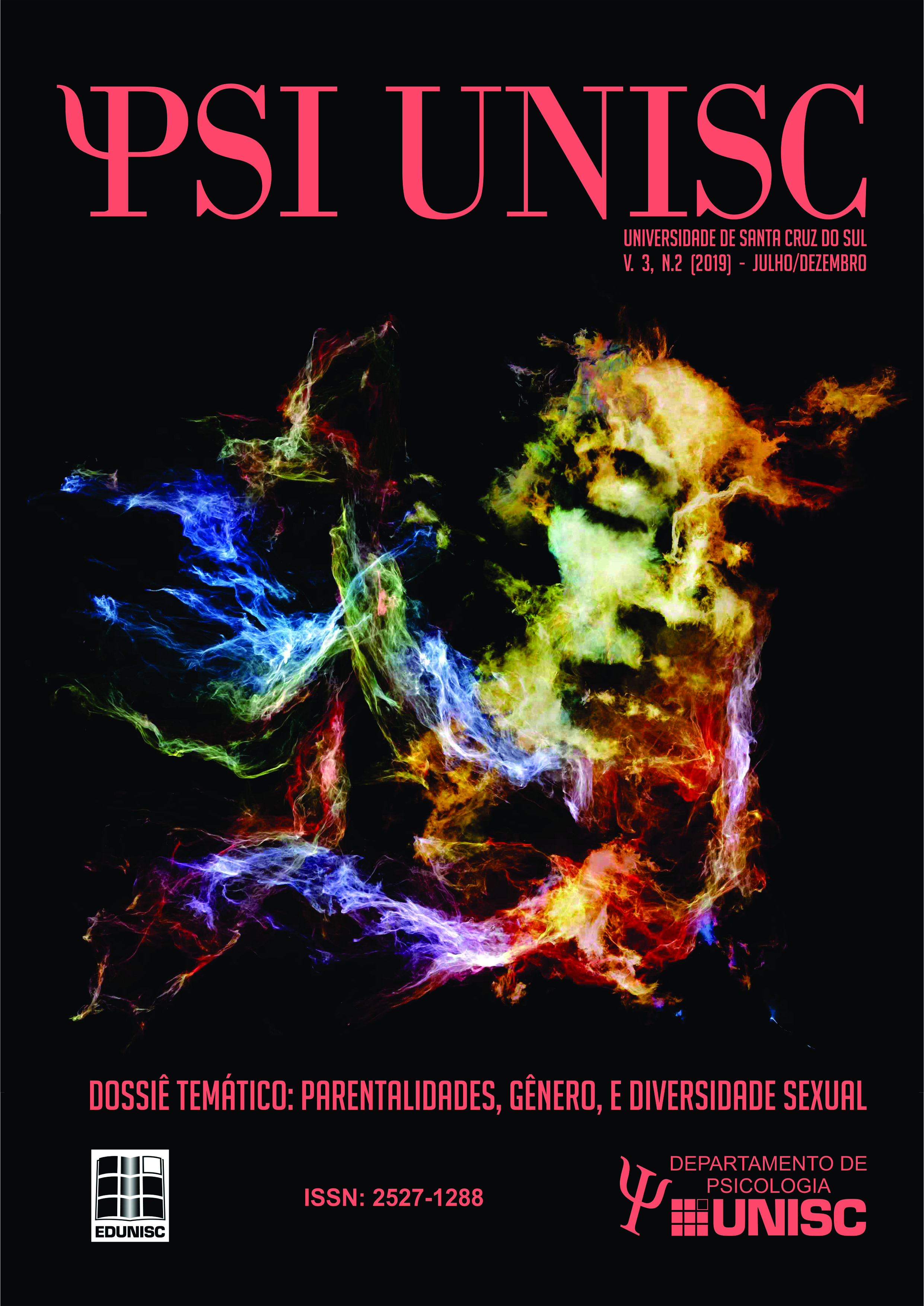Discourses of Violence Against Women LBT: Invisibility and Silencing
DOI:
https://doi.org/10.17058/psiunisc.v3i2.13392Keywords:
Violence, Women LGB, Discourse analysis.Abstract
The violence against women, even when it’s fought daily through laws and militances, is still very present in Brazilian society, producing in different ways and reaching all groups of women. This research aimed to understand the discourses on violence against lesbian, bisexual, transvestite and transgender women, understanding that they are at particular risk of violence, because, in addition to suffering from gender inequality prevailing in society, they escape from the cis-heteronormative pattern. The work starts from the theoretical-methodological perspective of Michel Pêcheux’s discourse analysis (1995). As a corpus, testimonials were collected online, through a post in a group on Facebook. The violence described is takes place in the public and private spaces, in a more or less explicit way. The violence as an effect is anchored in a conservative discursive formation that takes the heteronormative pattern as a rule. The analysis also pointed to the difficulty of naming the situations of violence experienced, as well as a policy of silence imposed in relation to the condition of women LBT.Downloads
References
Associação Nacional de Travestis e Transexuais [ANTRA]. (2018). Violência crescente contra pessoas trans em 2018. Recuperado de https://antrabrasil.org/2018/03/29/violencia-crescente-contra-pessoas-trans-em-2018/
Blay, E. A. (2008) Assassinato de mulheres e direitos humanos (34ª ed.). São Paulo: USP.
Brandão, H. H. N. (2004). Introdução à análise do discurso (2ª ed.). Campinas, SP: Editora da Unicamp.
Dinis, N. F. (2011). Homofobia e educação: quando a omissão também é signo de violência. Educar em Revista, (39), 39-50. doi: 10.1590/S0104-40602011000100004
Dinis, N. (2014). Por uma Pedagogia Queer. Itinerarius Reflectionis, 9(2). 10.5216/rir.v2i15.27710
Facebook. (2019). Informações da empresa [Site institucional do Facebook]. Recuperado de https://br.newsroom.fb.com/company-info/
Fragoso, S., Recuero, R., & Amaral, A. (2011). Métodos de pesquisa para internet. Porto Alegre: Sulina.
Jesus, J. G. (2012). Orientações sobre a população transgênero: conceitos e termos (2ª ed.). Brasília: Autor, Recuperado de https://www.sertao.ufg.br/up/16/o/ORIENTA%C3%87%C3%95ES_POPULA%C3%87%C3%83O_TRANS.pdf?1334065989
Indursky, F., & Ferreira, M. C. L. (Orgs). (2007). Análise do discurso no Brasil: mapeando conceitos, confrontando limites. São Carlos: Claraluz.
Oliveira, R. C., Lima, J. C. P. & Arana, A. M. F. R. (2017). Da criação das DEAM´s à Lei Maria da Penha: uma reflexão sobre a questão da violência contra as mulheres. Revista Ártemis, 24(1), 201-213.
Orlandi, E. P. (2015). Análise de Discurso: princípios e procedimentos (12ª ed.). São Paulo: Pontes Editores
Orlandi, E. P. (2007). As formas do silêncio: no movimento dos sentidos (6ª ed.). Campinas, SP: Editora da UNICAMP
Pêcheux, M. (1983/2014). A análise do discurso: três épocas. In F. Gadet, T. Hak (Orgs.), Por uma análise automática do discurso: uma introdução à obra de Michel Pêcheux (2ª ed., pp. 307-315). Campinas: Ed. da UNICAMP.
Pêcheux, M. (1995). Semântica e discurso: uma crítica à afirmação do óbvio (2ª ed.) (E. P. Orlandi et al., Trad.). Campinas, SP: Editora da UNICAMPI.
Pêcheux, M. (2008). O discurso: estrutura ou acontecimento (5ª ed.) (E. P. Orlandi Trad.). Campinas, SP: Pontes Editores.
Pinsky, C. B., & Pedro, J. M. (orgs). (2013). Nova História das Mulheres no Brasil. São Paulo: Contexto.
Recuero, R. (2009). Redes sociais na internet. Porto Alegre: Sulina. Recuperado de http://www.ichca.ufal.br/graduacao/biblioteconomia/v1/wp-content/uploads/redessociaisnainternetrecuero.pdf.
Sacramento, L. T., & Rezende, M. M. (2006). Violências: lembrando alguns conceitos. Aletheia, (24), 95-104. Recuperado de http://pepsic.bvsalud.org/scielo.php?script=sci_arttext&pid=S1413-03942006000300009
Solnit, R. (2017). A mãe de todas as perguntas: reflexões sobre os novos feminismos. São Paulo: Companhia das letras.
Souza, D. P., & Cararo, A. (2017). Extraordinárias: mulheres que revolucionaram o Brasil. São Paulo: Seguinte.
Stevens, C., Oliveira, S. R., & Zanello, V. (2014). Estudos feministas e de gênero: articulações e perspectivas. Florianópolis: Ed. Mulheres.
Waiselfisz, J. J. (2015) Mapa da Violência 2015: Homicídio de mulheres no Brasil. Recuperado de https://www.mapadaviolencia.org.br/pdf2015/MapaViolencia_2015_mulheres.pdf
Downloads
Published
How to Cite
Issue
Section
License
The submission of originals to this journal implies the transfer, by the authors, of the printed and digital publication rights. The copyrights for the published articles are those of the author, with periodical rights on the first publication. Authors may only use the same results in other publications clearly indicating this journal as the medium of the original publication. Because we are an open access journal, we allow free use of articles in educational and scientific applications provided the source is cited under the Creative Commons CC-BY license.




